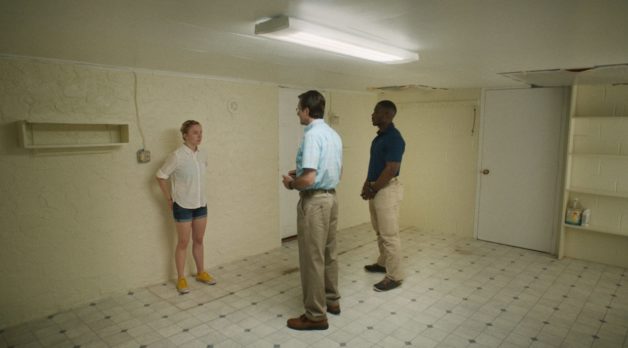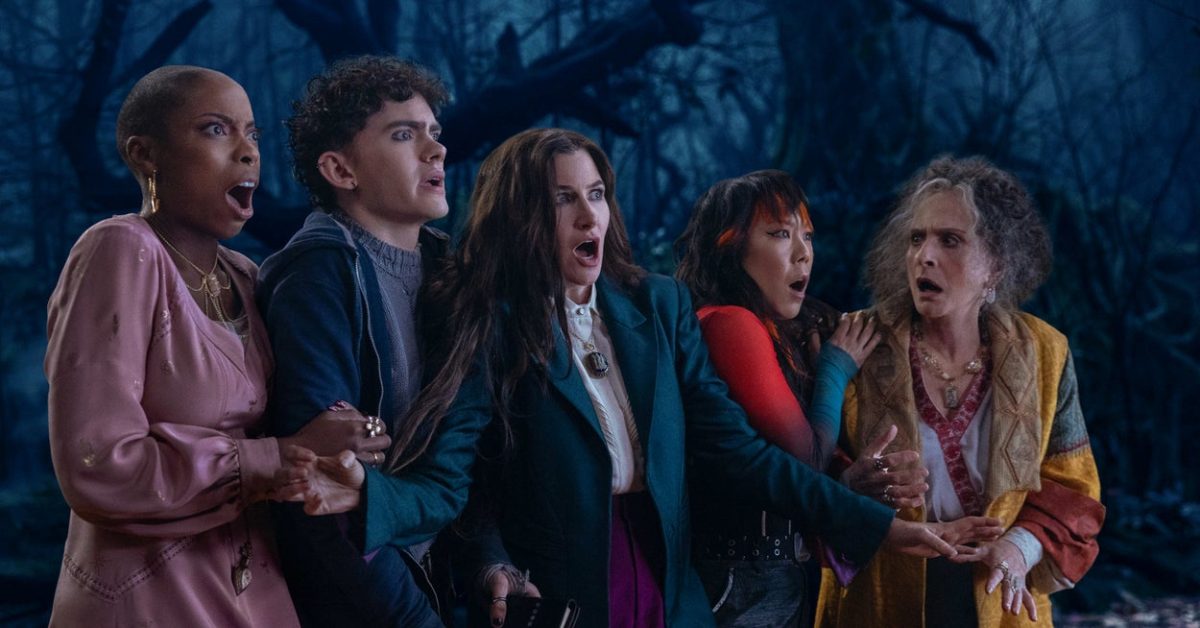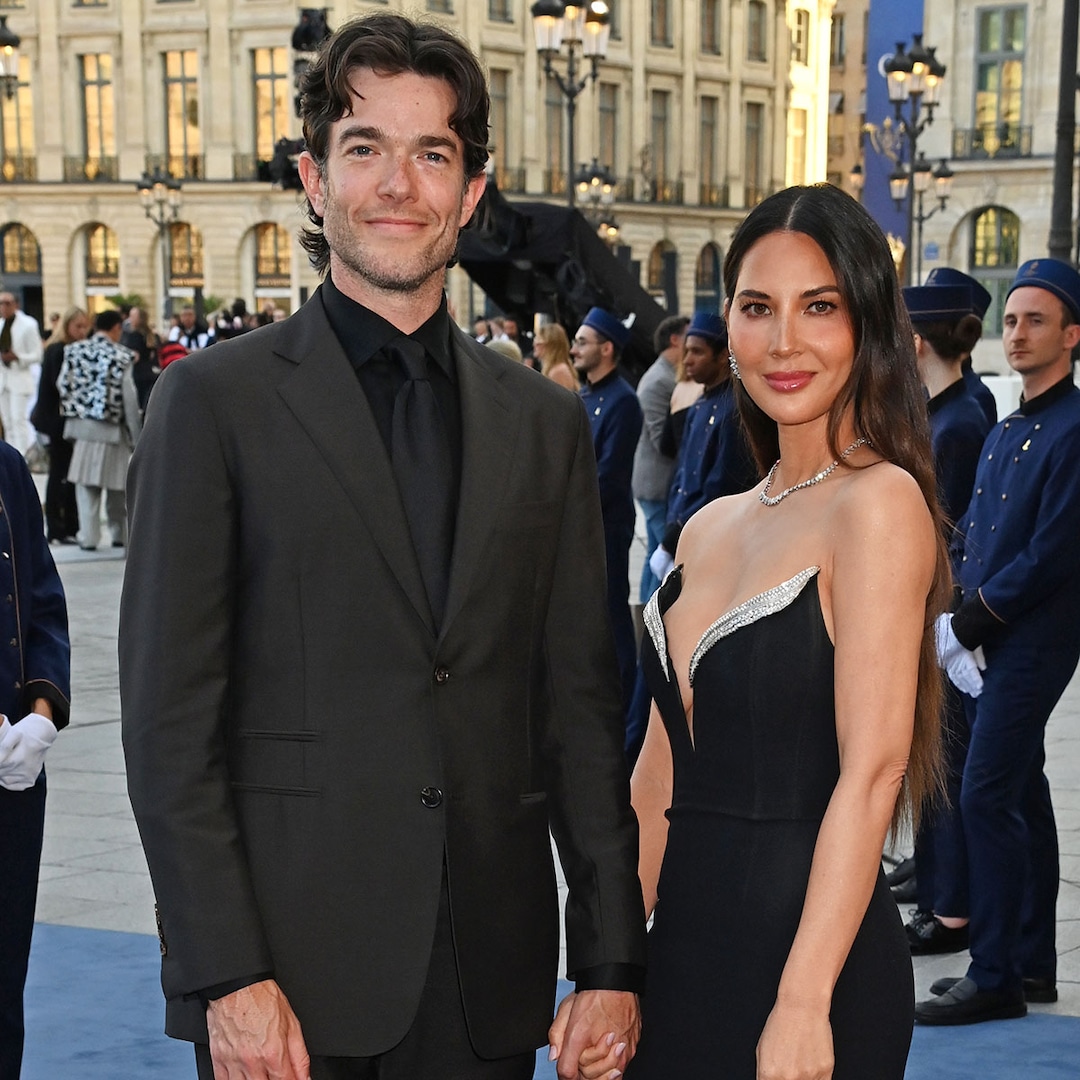
“Second by Second, She is Trying to Game Out What to Say Next…”: Writer/Director Tina Satter on Her Sydney Sweeney-Starring Berlin Premiere, Reality
Feb 20, 2023
Reality
Tina Satter’s Reality opens with a high-angle shot of its eponymous heroine, Reality Winner, her blonde head poking up amongst a stretch of cubicle dividers in a Georgia NSA facility. It’s 2017 and above her on the walls are an array of television monitors, chyrons blaring, all tuned to the latest news about James Comey’s Congressional testimony regarding Russian election interference. The channel is Fox, and you don’t have to be at any particular place on the political spectrum to view this work environment as already an abusive one. Winner works translating Farsi to English, a task that requires sensitivity, awareness and nuance — how do it with that media sludge overhead? At one point later in the picture, she wonders to the duo of FBI agents interrogating her, why couldn’t those monitors just have been set to pet picture photo galleries?
Juxtaposing the quotidian amidst matters of immense national significance — not just about fair elections but also the right of whistleblowers to call out government obfuscation — is the tremendously rewarding dramatic strategy of Satter’s Berlin-premiering picture. With the exception of that opening shot, a sort of preamble set in Winner’s front yard, and moments of montage material, the film is set entirely in her house, her personal space being invaded by a team of forensic FBI agents as she’s questioned in an odd, unfurnished yellow-ish side room, a sort of liminal space. The film’s dialogue is taken entirely from the FBI agents’s real-life transcript of the afternoon, in which the NSA contractor was interviewed about and arrested for leaking classified documents to The Intercept. The agents’s speech is filled with bureaucratic faux concern (the location and water-bowl status of Winner’s cat and dog take up much word count) and overly obvious attempts at bonding — interrogation strategies that we instantly recognize as such even as, watching Winner attempt to evade their linguistic traps, we understand them to be effective. As Winner, Sidney Sweeney is a cool revelation. If her Cassie Howard in Euphoria has, over the course of two seasons, been driven to increasingly emotional heights by the series’s storyline, here Sweeney skillfully achieves the opposite, compellingly portraying a normal woman in extraordinary circumstances for whom breaking down could place her life in jeopardy.
Reality is Satter’s first film, and in our interview below, she states that she was initially fascinated by the dramatic potential of the transcript, a sort of found text, without thinking necessarily of the medium that text could be adapted to. It could be a play or movie, she thought. As an acclaimed playwright, it was natural for Satter to first present it as a play, and the resulting production, Is This a Room (after that odd, yellow-ish liminal space) was a hit, as I detailed in my 2022 25 New Face interview. For the work’s terrific translation to screen, Satter has imaginatively broadened her stylistic palette while never descending into any kind of gimmicky. Much of the film is simply comprised of close-ups and masterfully edited shot-countershots, and for the transcript’s bits of redacted texts, Satter employs startling visual glitches that, as she describes below, impart another layer of coded meaning to the work. The overall effect is a paradoxical blend of the soberly analytical and deeply emotional; when Winner’s interrogation reaches its conclusion, the stakes register as both Winner’s and ours.
I spoke to Satter just a couple of weeks after she completed Reality and just a few days before the film’s premiere in Berlin, where so far it’s one of the Panorama section’s critical hits.
Filmmaker: When we talked previously, you were in post, and now that you’re finished, I’m curious if the structure of the film has mirrored exactly the play’s structure. Obviously there’s a chronological structure to the story that was never going to change, but within that, did you find new structural rhythms, if that makes sense?
Satter: I was totally finding new structural rhythms. Once I started translating it into a screenplay, helpfully and magically the play fell away. Literally putting it into Final Draft wiped [the play] from my brain. But I had always thought that this content could be a film, even though I had never made a feature or a play. Per your point, [the structure] is what it is. The way we [in the movie] treated the sort of temporal break of the redactions felt as close to what I sometimes thought about in the play. How do we cut action and keep going? The redactions were a formal concern, and in the movie they were their own exciting, very challenging thing to sort out. I’m happy with what we came to with those. The artistic treatment is, I think, very special — how we got to leave the picture like that, or at least strike the actors from the picture [at moments]. How do you keep going [after those moments] and keep people understanding that it is real? The redactions came down to this editing dance with [editor] Jennifer Vecchiarello.
Filmmaker: Were they were they always motivated by whatever kind of legal or textual issues there were in the transcript, or did you find yourself creating new redactions that weren’t in the original document to suit the rhythm of the film?
Satter: No, I stuck to the rigor of treating [the redactions] where they were in the document. I liked that constraint, you know.
Filmmaker: And what about the text itself? Were you ever tempted to diverge from the real-life order of the transcript in order to shape the edit in a certain way?
Satter: Sometimes in the darkest moments of the edit, we were like, “Should we just do it, move something around?” And then we were like, “No, let’s do the work of trying to make it work but holding it temporally with cutting and all that stuff.” In the end, it was rewarding work to have gotten to.
Filmmaker: Let’s talk about the particular effect you created for the redactions, which is so interesting, these visual glitches. What was the process of getting to the aesthetics of those?
Satter: Tommy Love, who was the production designer, we just really clicked in a great way from the second we started prepping for the movie. Tommy, like many production designers, is trained also as a visual artist. In the screenplay, the redactions were these weird visual collages that, frankly, I hadn’t fully thought of how they would [appear in] the film. In prep, Tommy and I would sometimes talk about this glitch process he used to do in part of his art practice. I was like, “There’s something about that, Tommy, I want to see your stuff.” And so then when we got to that part of the edit, he started sharing them with me. Some of what he’s doing in that process is totally degrading actual video he’s already shot. [I thought], let’s go further with that. So it’s a kind of a secret, amazing part of the movie because what those glitches are made from is distorted Fox News and other things that are then run through his weird artistic process and editing treatments. But there are actual layers of referential relevant stuff each time they appear. I like that it’s a weird resident secret, and it gives the right filmic feeling.
Filmmaker: I have to say, that first shot, the overhead in the office, with the Fox News monitors — I thought, it would be hell to work in that place.
Satter: Totally. Learning [about that] in the transcript, it was like, what would that feel like [to be working in such a space]? It was a little bit of a discovery to actually put that [scene] first, but it felt right and touched things I’d always been interested in about [the world] Reality herself had lived in up to this.
Filmmaker: When we spoke before you brought up kind of the power of the close up. Sydney’s amazing in the film, and I was noticing those moments that you went to close up. I was so aware that, you know, she’s obviously lying, and I was impressed by her performance of lying.
Satter: [After] not getting to go in close on Reality’s face [in the play], with Reality as portrayed by Sydney, I was like, we can finally go there! And because the landscape of the movie is the faces and people talking, closeups were so exciting — to finally sort of detonate them in the plan for shooting. On the first day [of shooting], once I realized what Sydney was going to be offering each take, like the little cheek quivers she gives, we knew closeups would be really powerful. To be really close to a person as, second by second, she is trying to game out what to say next while dealing with the fact that she knows her life is changing by the second — closeups can do that. We don’t ever go as close on the guys, the agents, but we are pretty close on them in a lot [of the shots]. It’s like she’s seeing them, they’re seeing her in this small white room. She’s the landscape we’re looking at too, so I wanted to show how “under the microscope” she was by the end.
Filmmaker: There are parts of the film that have these surreal flourishes, where the camera tilts and the visual language shifts, almost as if she’s disassociating. Were those scripted? Were those accentuated more in post? Tell me about some of those moments where the realism breaks a bit.
Satter: Those were scripted. I’d always been intrigued by this idea that after she’s confessed, she’s stepped over the edge of something, so what does that feel like? You’re trying to calculate what your life is [now], but you’re still sort of caught in this weird conversation. I always imagined her brain could go somewhere weird, especially when they start talking about her cat again. So, yeah [how we shot it] is pretty close to how we scripted it, but I still thought of the script as a gesture, or a map, for some of the stuff we wanted to find in the edit. We shot with an effect that slowed down the camera for the talk about the cat. And I had in the script that she looks over and sees a bug crawling up the wall and really focused on it. That became the snail. We shot a number of bugs and bees, and when we looked at them in post, the snail ones were so incredibly beautiful.
Filmmaker: Reality was adapted from your play, and as we’re talking you’re in the midst of prepping another play. In most cases, film production works on such an industrialized, regimented model. Did you find that different to theater? And, looking back, how did you as a creative person take to the difference in the process?
Satter: In many ways the regimentation is so useful because it’s such an organizing principle, especially for prep and shooting. I mean, it happens at an insane pace, and that’s wild, but you’re so prepped and planned and then there’s an incredible ecosystem once you’re shooting where all the departments are somehow seamlessly seeming to talk to each other in the crazy pace of a shooting day. In many ways from doing tech in theater, I was very used to working so fast, having to make decisions where it feels chaotic. So that regimentation, where it’s a little more set out, was interesting to me. But what was fascinating to me was the post process, where you do the edit, then you do color and then you do sound. At first my brain was like, shouldn’t this all be happening together? Then it would feel more like theater tech, where you’re all in the room as you make a light change, and you’re right there in the spot as you do sound. But I think there’s such a minutia to film — we were literally doing some tweaks up until about two weeks ago on color. I understand so much more now about that need and that process. I remember the first time they were talking to me about breaking [the cut] into reels. I’m like, you live and die by the reel breaks! All this passing back and forth between sound and color and these final finesses and editing. But I think I’m good at adapting my art brain because I like constraints, so I was able to transition: “All right, this is how we work. Great. How do I work within this efficiently?”
Filmmaker: Were there restraints that you really bristled at or resented?
Satter: I mean, at first [in post] I [thought], “We should all be in a giant warehouse, color’s happening over there, and Jennifer Vecchiarello gets the desk in the center.” But no, not personally, because I had such a great relationship with the producers, who were such amazing creative partners. But it was funny to me, when we did the first sound pass, I was like, “This changes so much, and I made a different choice in the edit.” Obviously on studio movies you can continue to make changes — there’s time and money for that. But in the indie world the constraint is real.
Filmmaker: What were some of the creative sound design ideas you wanted to work with?
Satter: I was really interested in when she’s outside the house [in the beginning], that sort of becomes a bed layer, but very subtle. I wanted the sound and score to be subtle overall and not be total drivers. So there was always a dance between the sounds being normal and then at certain moments rising up for what I think of as “sound design score.” I wanted it to feel like it was all vibrating in the air while not pushing stuff. At certain moments the cicadas rise up, and then there are certain loud clanks that happen. [In the beginning], it was like, should the [sound design] be driving more, or should it be covered in score? But once we saw what we had in those performances, it was like, how do we just carve around the energy moving between Garrick [an FBI agent played by Pete Simpson] and Reality?
Filmmaker: There’s a montage at the end of the movie, something that breaks from the concept of just being being within the world of the transcript. Was that scripted or was it something you discovered later the film needed?
Satter: It was in the script. I put in, “Flash to real pictures of Reality” as a kind of placeholder idea, kind of not knowing exactly how that could or work work. I talked about this to the producers — how do we thread, artfully, the showing that [Reality] is real but also keep the integrity on what Sydney and the actors are doing? It’s such a fine line. And so they are very lightly in there.
Filmmaker: I love the way you threaded those photos of Reality throughout the picture. You know, it’s such a trope of these kind of films that adapt real-life situations — there’s an actor playing a real person, and then at the end a cut to the real photo. Sometimes that feels beautiful and impactful, and sometimes it can feel gimmicky.
Satter: A little sentimental in the wrong way.
Filmmaker: Yes. Having them peppered throughout — it almost had a kind of Brechtian quality. Definitely non-sentimental.
Satter: Right. It’s like, “This happened.” As for the [closing montage], once we had a more full early cut, we started thinking about archival, and that was a pretty long process of discovery. And then it was important the score by Nathan McKay encased in the right kind of sound — not sad but also kind of weird. Like Reality Winner herself is so major a person that she’s going to be able to go on, and I wanted the score around those images to hold that too.
Filmmaker: Has Reality seen it? What’s her relationship to the film at this point?
Satter: Reality has not seen it. I don’t think Reality wants to see it, or at least not yet, which makes a total sense to me. But we have a great working relationship and even a version of a friendship at this point. Her mom and sister, Billy Winner Davis and Brittany Winner, have seen it, and they’re a very close unit. They watched it for themselves, and I think a bit for Reality. They’re really her proxies, and they going to be in Berlin with us. They were thrilled by the cut, which was, honestly, the most nerve-wracking part of this process. But the day I sent them the link, I just then had to put it out of my brain until I heard from them that they were really moved by it. They felt like it was a really strong and important portrayal of their daughter and this event.
Publisher: Source link
Every New Character Added To The MCU
Agatha All Along: Every New Character Added To The MCU Realizing that Wanda took all her power, Agatha's solution lies at the end of The Witches' Road, a series of trials that will reward those with what they are missing…
Oct 26, 2024
John Mulaney Shares Emotional Tribute to Wife Olivia Munn
"She shared her story to help anyone she could," John, who wed Olivia in July after three years together, continued. "According to the National Cancer Institute, in the week after Olivia shared the story of her breast cancer journey, there…
Oct 26, 2024
Eva Mendes Said There Have Been Times Where She’s “Regretted” Getting Cosmetic Work Done And Had To “Wait It Out”
Eva, who turned 50 this year, has previously said she would “never deny” getting cosmetic work done.View Entire Post › Disclaimer: This story is auto-aggregated by a computer program and has not been created or edited by filmibee.Publisher: Source link
Oct 25, 2024
Nicole Kidman Confirms Another Iconic AMC Ad Is “In the Making”
Nicole Kidman's 16-Year-Old Daughter Looks All Grown Up in Rare Public AppearanceWe come to this place for Practical Magic. At least, that’s a past role Nicole Kidman is channeling to tease that another AMC ad—like the movie theater chain’s original…
Oct 25, 2024










